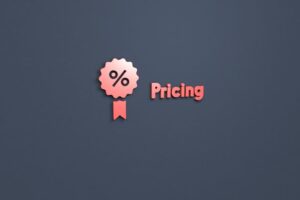Competitive pricing is a strategy that allows businesses to set their product prices based on their competitors’ prices, with an emphasis on market trends instead of production costs or market demand. The main goal of competitive pricing is to position a product in the market to compete while remaining profitable.
In competitive pricing, you have three primary strategic choices, which include:
- Pricing your products higher,
- Pricing your products lower,
- Matching your competitors’ prices.
Pricing your products higher often requires you to justify the increased cost through improved features or superior product qualities than your competitors.
Pricing your products lower, on the other hand, can be a way to attract price-sensitive customers, giving you an advantage in the market and establishing your market share.
However, by matching prices with your competitors, customers could perceive your product as equal in value to that of your competitors, which allows them to make buying decisions based on other factors.
Using this strategy can help build trust and reliability with customers. They might consider your product to be on the same level as other established brands, which can increase customer loyalty and repeat purchases.
The competition between Coca-Cola and Pepsi is one of the most well-known examples of competitive pricing. These two beverage giants regularly monitor each other’s pricing strategies and promotional activities.
For instance, if Pepsi releases a new product at a competitive price, Coca-Cola might respond by releasing a similar product or lowering the prices it already has. They also compete in promotion battles, offering discounts, bundles, or limited-edition products to gain market share.
MORE: What is geographical pricing?

Types of Competitive Pricing Strategies
There are three popular types of Competitive Pricing strategies that many companies adopt, depending on their needs and size. They include penetration pricing, promotional pricing, and captive pricing.
Penetration Pricing
Penetration pricing allows businesses to set a lower price for a new product or service during its initial phase in the market.
The pricing model aims to gain significant market share quickly by offering products at a lower price than competitors.
By implementing a penetration pricing strategy, new businesses can quickly onboard many users, gather feedback, analyze, and define their market position.
Example of penetration pricing
A good example of penetration pricing in the software industry is the introduction of Microsoft’s Office 365 when it was initially launched.
When Microsoft introduced Office 365, it provided a subscription-based model for its popular productivity suite, including applications like Word, Excel, PowerPoint, and others.
However, to make it accessible to all levels of users, Microsoft offered various subscription plans, including plans for individual users, small businesses, and larger enterprises.
The subscription pricing model made it more affordable for users to access the latest software updates and services without the upfront cost of purchasing a software license, which increased their customer base.
Promotional Pricing
Promotional pricing is a pricing strategy that provides a product or service at a discounted price for a limited time.
Promotional pricing is typically used to increase product awareness, gain new customers, clear out old inventory, or generate buzz for a new product launch.
Promotional pricing can take many forms, including discounts, buy-one-get-one-free offers, or coupons.
The strategy typically encourages consumers to make impulse purchases by creating the impression that they are getting a good deal.
Example of promotional pricing
Black Fridays and Cyber Mondays are great examples of promotional pricing strategies.
Many retailers offer significant discounts on various products during these events to boost sales and attract customers.
Additionally, promotional pricing is time-limited, usually lasting for a day or a weekend.
This limited time creates a sense of urgency among consumers, encouraging them to take advantage of the discounts before they expire.
Captive Pricing
Captive product pricing is a strategy where a company sets the price of one product in relation to another product.
For instance, a company might sell a printer at a low price but charge more for ink cartridges, knowing customers will need them to use the printer.
This approach is often used in industries where the main product requires accessories to operate.
A lower-priced main product attracts customers, and the higher-priced related items can generate profits. This pricing model is usually employed in industries like consumer electronics and technology.
Example of captive pricing
Captive pricing is usually utilized more in industries that offer products that require accessories to operate. The main product is usually sold at a lower price, while profits are generated from its associated product.
Take, for example, HP Printers and Ink Cartridges. HP often sells its printers at a relatively low cost, making them accessible to a wide range of consumers. The low initial cost attracts customers to choose HP printers over competitors.
However, ink cartridges are necessary for printers to function and are sold separately at a higher price margin than printers.
Additionally, HP printers use technology that makes it difficult for consumers to use third-party or generic ink cartridges.
This approach leaves customers with the choice of purchasing only HP-branded ink cartridges, ensuring a captive market for consumables.
MORE: What is charm pricing?
Tips for Implementing Competitive Pricing
Understand Your Market and Audience
Understanding your prospective buyers’ needs, pain points, and expectations is important. To do that, you must analyze user behavior, adoption of similar services, market trends, and the competitive environment in detail.
Having a clear understanding of these factors will help you tailor your product and pricing strategy to meet market demands.
Gather Comprehensive Data
Collect data about your target audience’s demographics, psychographics, technology use, and behavior.
To develop features and pricing strategies that resonate with people, it is necessary to develop accurate user personas.
MORE: What is psychological pricing?
Examine the Market Landscape
Assess the market’s size, growth rate, ongoing trends, and the key drivers of change. To thoroughly understand the market, utilize various tools and resources, including industry reports, expert interviews, and online data tools.
Doing this enables you to discover potential opportunities for new product development and adjustment opportunities to your current strategies.
MORE: How do trial pricing strategies work?
Pros of Competitive Pricing
The following are the advantages of competitive pricing strategy:
Simplicity and Ease of Implementation
Implementing competitive pricing requires basic market research to understand competitors’ prices. The simplicity allows businesses to adjust pricing strategies in response to market changes.
Low Risk and Quick Results
Since competitive pricing is based on market rates set by competitors, it is inherently low-risk.
Businesses can stay aligned with market trends, potentially leading to quick market penetration and revenue growth results.
Increased Traffic and Market Share
Utilizing a competitive pricing strategy, especially by providing lower prices or matching competitors’ prices, can increase foot traffic (both online and offline), build brand loyalty, and help gain, maintain, or increase your market share.
Flexibility
Businesses can combine this approach with other pricing strategies such as cost-plus, value-based, or demand pricing, enabling them to fine-tune their pricing approach according to different market conditions and business goals.
MORE: What is price anchoring?
Cons of Competitive Pricing
The following are the disadvantages of competitive pricing:
Missed Opportunities
Solely relying on competitor pricing can sometimes lead to missed opportunities for revenue growth.
There’s a risk of undervaluing your product or service if you don’t consider its unique value proposition.
Potential Difficulty Covering Costs
Focusing only on competitive pricing might not always cover the costs of production or business overhead, which could become a potential financial strain.
Reliance on Competitor Data
Basing your pricing solely on competitors’ strategies can be risky, especially if their pricing is not optimized or they make errors in their pricing decisions.
MORE: What is enterprise pricing?
Competitive Price Analysis: How to Do It
Identify Your Competitors
Start by identifying who your actual competitors are. You can easily do this by conducting a Google search with keywords relevant to your product.
You can use SEO analysis tools such as SEMRush, Moz, and Ahrefs to enhance your search results and identify your competitors.
Gather Pricing Data
Once you have identified your competitors, the next step is to gather their pricing data. You can start by checking their websites, searching for resellers or distributors, browsing public forums like Reddit or LinkedIn, and contacting industry contacts and experts.
Another effective way to gather information is by asking your customers and prospects about the pricing they’ve come across when dealing with your competitors.
Analyze the Data
Once you have the data, analyze it to identify trends. Consider how competitors position themselves – are they a budget or premium option? How often do they change prices?
Ensure to consider their overall marketing and positioning strategies when conducting your analysis.
Draw out Your Plan
Based on your findings, determine if you need to adjust your pricing strategy.
Do you need to change your prices, or can they stay the same? Look for new trends by comparing your current data with historical data.
Monitor Competitors Regularly
Competitive price analysis is an ongoing process. Regular monitoring helps you to stay current and adapt your plan to remain competitive. If a rival changes their prices, you will want to react accordingly.
MORE: How is economy pricing different from competitive pricing?
Is Competitive Pricing Right for My Business?
To determine whether competitive pricing is appropriate for your business, consider market saturation, product differentiation, cost structures, consumer perception, and brand positioning in your industry.
In a crowded market, competitive prices can help your product stand out. However, if your product is unique or has premium quality, value-based pricing may be more effective. Your price must cover expenses while maintaining profits.
If your clients are price-sensitive, competitive pricing could be the best option for you. However, you may want to consider a higher price point if they prioritize unique features over costs.
Finally, you must consider your company’s objectives, the market, and your product’s value proposition when deciding whether competitive pricing is the right strategy.
Adopting competitive pricing should align with your entire business strategy and market positioning, as every business is different.
MORE: What is loss leader pricing?
Key Takeaways
In conclusion, competitive pricing requires careful thought and analysis. It’s effective for standing out in a busy market, but you must also weigh your unique offerings, costs, and what your customers expect regarding pricing.
Your pricing strategy should align with customer expectations and their sensitivity to price changes.
For more pricing information to help you develop your own strategy, visit our SaaS Pricing pages.
Related Posts
Frequently Asked Questions (FAQ)
Author
Methodology
- Who?
We are SaaS experts: Our specialists constantly seek the most relevant information to help support your SaaS business. - Why?
We are passionate about users accessing fair SaaS pricing: We offer up-to-date pricing data, reviews, new tools, blogs and research to help you make informed SaaS pricing decisions. - How?
With accurate information: Our website manager tests each software to add a Genius Score using our rating methodology to each product. Our editorial team fact-check every piece of content we publish, and we use first-hand testing, value metrics and leading market data.










